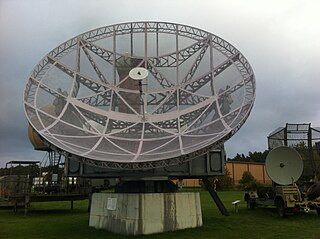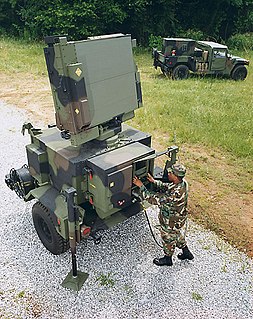
The low-UHF band Würzburg radar was the primary ground-based gun laying radar for the Wehrmacht's Luftwaffe and Heer during World War II. Initial development took place before the war and the apparatus entered service in 1940. Eventually over 4,000 Würzburgs of various models were produced. It took its name from the city of Würzburg.

3D radar provides for radar coverage in three dimensions; unlike the more common 2D radar which provides range and bearing, the 3D radar also provides elevation. Applications include weather monitoring, air defense, and surveillance.

The AN/MPQ-64 Sentinel is a 3D radar used to alert and queue Short Range Air Defense (SHORAD) weapons to the locations of hostile targets approaching their front line forces. The Sentinel radar is deployed with forward area air defense units of the U.S. Army. It is an X-band range-gated, pulse-Doppler radar system. The antenna uses phase-frequency electronic scanning technology, forming sharp 3D pencil beams covering large surveillance and track volume. The radar automatically acquires, tracks, classifies, identifies and reports targets, including cruise missiles, unmanned aerial vehicles, and both rotary- and fixed-wing aircraft. It uses a high scan rate and operates at a range of 40 km (25 mi). The radar is designed with high resistance to electronic countermeasures (ECM). Mounted on a towed platform, it can be positioned remotely from the rest of the unit, operated autonomously and communicate with the Fire Direction Center (FDC) via wideband fiber-optic link. It can also distribute its data over a SINCGARS radio network.

Precision approach radar (PAR) is a type of radar guidance system designed to provide lateral and vertical guidance to an aircraft pilot for landing, until the landing threshold is reached. After the aircraft reaches the decision height (DH) or decision altitude (DA), guidance is advisory only. Controllers monitoring the PAR displays observe each aircraft's position and issue instructions to the pilot that keep the aircraft on course and glidepath during final approach. It is similar to an instrument landing system (ILS) but requires control instructions. One type of instrument approach that can make use of PAR is the ground-controlled approach (GCA). Air traffic controllers must transmit a minimum of every 5 seconds to the pilot their relation to the azimuth portion and, once intercepting the glidepath, their elevation. The approach is terminated when the aircraft reaches the OCA/H. Nevertheless, information is provided until threshold and aircraft may be monitored by controller until touchdown. Controller in charge of PAR should not be responsible for any duty other than the PAR approach concerned.
The AN/ALR-67 Radar Warning Receiver is designed to warn an aircraft's crew of potentially hostile radar activity. It is an airborne threat warning and countermeasures control system built to be successor to the United States Navy's AN/ALR-45. Northrop Grumman Corporation's Electronic Systems sector was the main contractor for the AN/ALR-67(V) and (V)2. Raytheon Electronic Warfare Systems was the main contractor for the AN/ALR-67(V)3.

A height finder is a ground-based aircraft altitude measuring device. Early height finders were optical range finder devices combined with simple mechanical computers, while later systems migrated to radar devices. The unique vertical oscillating motion of height finder radars led to them also being known as nodding radar. Devices combining both optics and radar were deployed by the U.S. Military.
The JY-8 is a mobile 3D air surveillance, target acquisition and interception control radar system operating in the C-band. It can be employed as the main radar sensor for an automated tactical defence system, or can be used as an independent radar. The system uses advanced signal/data processor techniques and is fully solid state with the exception of the magnetrons and thyratrons of the transmitters. The general designer of JY-9 is the head of 38th Research Institute, academician of Chinese Academy of Sciences Mr. Wu Manqing, who is also the general designer of JY-9 and the general designer of the radar systems for KJ-2000 and KJ-200.
The JLP-40 is a tactical air defense radar designed to use with height finding radars such as the JLG-43 Radar. It is similar in design to the Russian "Bar Lock" series radar and may have been derived from it as part of the sale of the SA-2 system from the Former Soviet Union in the early 1960s. It features the same arrangement of the two large scanners attached to front and ear sides of a rotating cabin that houses the transmitter/receivers.

The AN/SPS-48 is a US naval electronically scanned array air search three-dimensional radar system manufactured by ITT Exelis and deployed in the 1960s as the primary air search sensor for anti-aircraft warships. The deployment of the AN/SPY-1 and the end of the Cold War led to the decommissioning of many such ships, and many of these vessels AN/SPS-48 sets were reused on aircraft carriers and amphibious ships, where it is used to direct targets for air defense systems such as the Sea Sparrow and RIM-116 SAM missiles. Existing sets are being modernized under the ROAR program to AN/SPS-48G standard for better reliability and usability.

The Saab Giraffe Radar is a family of land and naval two- or three-dimensional G/H-band passive electronically scanned array radar-based surveillance and air defense command and control systems tailored for operations with medium- and Short Range Air Defense (SHORAD) missile or gun systems or for use as gap-fillers in a larger air defense system. The radar gets its name from the distinctive folding mast which when deployed allows the radar to see over nearby terrain features such as trees, extending its effective range against low-level air targets. The first systems were produced in 1977. By 2007, some 450 units of all types are reported as having been delivered.
A radar display is an electronic device to present radar data to the operator. The radar system transmits pulses or continuous waves of electromagnetic radiation, a small portion of which backscatter off targets and return to the radar system. The receiver converts all received electromagnetic radiation into a continuous electronic analog signal of varying voltage that can be converted then to a screen display.

The AN/FPS-16 is a highly accurate ground-based monopulse single object tracking radar (SOTR), used extensively by the NASA manned space program, the U.S. Air Force and the U.S. Army. The accuracy of Radar Set AN/FPS-16 is such that the position data obtained from point-source targets has azimuth and elevation angular errors of less than 0.1 milliradian and range errors of less than 5 yards (5 m) with a signal-to-noise ratio of 20 decibels or greater.
Electronics and Radar Development Establishment (LRDE) is a laboratory of the Defence Research & Development Organization (DRDO). Located in C.V. Raman Nagar, Bangalore its primary function is research and development of Radars and related technologies.

The P-18 or 1RL131Terek is a 2D VHF radar developed and operated by the former Soviet Union.

The P-15"Tropa" or 1RL13 is a 2D UHF radar developed and operated by the former Soviet Union.
The P-70 or "Lena-M" was a static 2D VHF radar developed and operated by the former Soviet Union.

The P-19"Danube"1RL134 is a 2D UHF radar developed and operated by the former Soviet Union. The radar was also known by the name "Renata" in Polannai" in the former German Democratic Republic.

Irbis-E is a Russian multi-mode, hybrid passive electronically scanned array radar system developed by Tikhomirov NIIP for the Su-35 multi-purpose fighter aircraft. NIIP developed the Irbis-E radar from the Bars radar system used on Sukoi SU-30MK aircraft.

The AN/FPS-6 Radar was a long-range height finding radar used by the United States Air Force's Air Defense Command. The AN/FPS-6 radar was introduced into service in the late 1950s and served as the principal height-finder radar for the United States for several decades thereafter. It was also used by the Royal Air Force alongside their AMES Type 80s. Built by General Electric, the S-band radar operated on a frequency of 2700 to 2900 MHz. Between 1953 and 1960, about 450 units of the AN/FPS-6 and the mobile AN/MPS-14 version were produced. The AN/FPS-90 and AN/FPS-116 radars were identical to the AN/FPS-6 except for receiver modifications.

The Nizhny Novgorod Research Institute of Radio Engineering (NNIIRT) is a Russian electronics company specializing in the development and manufacturing of radar equipment. It is a subsidiary of the Almaz-Antey group.